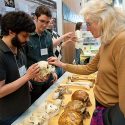Chinese high schoolers to learn from stem cells
Eighteen students participating in the inaugural Global Wisconsin Idea Program — a unique pairing of American and Chinese teenagers — will join a Chinese university dean this week to learn more about the science of stem cells during a hands-on workshop hosted by the Morgridge Institute for Research.
The workshop, to be held Wednesday, July 27, is part of a three-week residential program that challenges students to explore global issues of sustainability and the promise of solutions among a variety of emerging research and technologies.
The Global Wisconsin Idea Program is a cross-campus collaborative effort developed by the Wisconsin Center for Academically Talented Youth, part of the School of Education at the University of Wisconsin–Madison, and UW–Madison’s Division of International Studies.
The stem cell workshop will feature an overview of research in the field and provide an opportunity for the students to work with stem cells using laboratory techniques developed by scientists to maintain, propagate and direct stem cells into specialized cells. The workshop will be held in the Wisconsin Institutes for Discovery building.
The students will learn about both human embryonic stem cells and induced pluripotent stem cells. Human embryonic stem cells are blank-slate, or pluripotent, cells that have the capacity to differentiate into any of the more than 220 cell types in the human body.
The human embryonic stem cell lines used by the students were established approximately 10 years ago and continue to play a vital role in international research because of their flexibility and well-documented performance characteristics. Induced pluripotent stem cells derived from reprogrammed adult skin cells show some differences from human embryonic stem cells and also are the focus of much promising research for development of disease models and in drug discovery.
The workshop is one of many enrichment experiences the Chinese and American students will participate in as part of their three-week stay on campus, which brings American and Chinese high school students together in a truly integrated learning and living environment.
UW–Madison currently hosts some 2,000 degree-seeking students from China, Hong Kong and Taiwan and efforts to promote cultural and academic exchanges have been a focus on campus for decades.
“Stem cell science is an interdisciplinary field that often requires collaboration from researchers at multiple universities. In many cases, this collaboration becomes international in nature,” says Rupa Shevde, a senior scientist and director of outreach experiences for the Morgridge Institute for Research. “By engaging these future leaders with the work going on here in Wisconsin, we are opening the door for potential future collaborations while building cultural understanding.”
Carole Trone, director of the Wisconsin Center for Academically Talented Youth, said the Chinese students are well-prepared for their in-depth learning experience here in Wisconsin.
“Although this is the first visit to the United States for most of our Chinese students, they arrived just two weeks ago with excellent English language skills and an energizing curiousity about research and innovation occurring here in Madison,” Trone says. “Our discussions between our American and Chinese students about globally important issues such as sustainability have been inspiring.”
The high school students are being joined in the workshop by Xu Xiaozhou, dean of the School of Education, Zhejiang University, China, who is participating in a separate academic and cultural exchange program.
Human embryonic stem cells were first isolated on the UW–Madison campus by James Thomson, who also was among the first to create induced pluripotent stem cells. Today, Wisconsin researchers are considered leaders in developing an understanding of these cells as they search for stem cell treatments and cures for diseases such as diabetes, Parkinson’s and heart disease.

